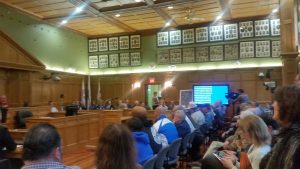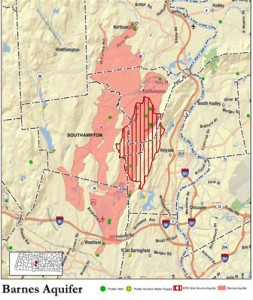WESTFIELD—Residents were lined outside the two entrances to the city council chambers at city hall last night, as the public forum on Westfield’s water drew a capacity crowd of concerned citizens.
The forum was hosted by the city and included Mayor Brian Sullivan, officials from several city departments, members from the Air National Guard and the Massachusetts Department of Environmental Protection (MassDEP). The information discussed had largely been previously discussed in other capacities but the collection was able to provide updates on the situation at large, and focused on the concerns of the water’s contamination of perfluourinated carbons (PFCs). Updates included private well testing by MassDEP, steps being taken by the Guard and where the city is in the process of getting carbon filtration systems put in place.

Residents fill the city council chambers, flowing out through the exits, during Tuesday night’s water public forum, held by Westfield Mayor Brian Sullivan
“I though it was well put-together and everyone did a good job of staying calm and cool and it went very well, very informative,” Joan Corell, resident of the city and attendee, said. “I’m proud of the people of Westfield.”
Sullivan said that the meeting was an “informal formal” meeting, with an intent to facilitate information for residents. This included the process by which the city had arrived to the situation of taking two wells—seven and eight—offline, and the steps that may be taken to alleviate the concern of PFC contamination.
The City
According to David Billips, director of the Westfield Department of Public Works (DPW), the city first started to address the issue when the Environmental Protection Agency (EPA) made two PFCs known as Perfluorooctanoic acid (PFOA) and Perfluorooctanesulfonic acid (PFOS) “compound[s] of interest” in 2013. At the time, the city’s water was below the then-threshold of 600 parts per trillion, which was put forth by the EPA.
However, in 2016 the EPA issued a lifetime health advisory that advised the amount be lowered to below 70 parts per trillion.
The city, according to Billips, acted proactively, taking wells seven and eight offline—which previously tested above 70 parts per trillion—knowing that the advisory was afoot.
As has been stressed before, officials on the city side were clear that this is not a single-time exposure level.
“It’s important to know the advisory is a lifetime advisory,” Billips said.
“They came out with this number of 70 parts per trillion as a limit for what they believe will be no health impacts at that level or below, that a pregnant or nursing mother would not have an impact at or below that level,” Heather Miller, systems engineer for Westfield, said.
According to Billips and Miller, the city has since been in the process of developing carbon filters for the two wells currently offline, which will aim to remove the contaminants from the water. Currently, they are gathering bench scale testing to set limits for the filters and to reduce the possibility of “clogging” the filters, like what happened in the Cape Cod region during a similar scenario.
The Guard
Currently, the 104th Fighter Wing located at Barnes Regional Airport is working on a four-step process to help alleviate concerns of residents, as well.
“We in the 104th Fighter Wing are 100 percent dedicated to environmental protection,” Col. James Suhr, commander of the Wing, said.
Concerns have been abound through the city and brought up in meetings that the Guard’s firefighting foam that was previously on the base may be the chief culprit behind the high amount of PFCs found in wells seven and eight. Both wells are located near the base, and the foam was used from “about 1970” until 1987 on the property, according to Suhr.
“Every air force base, including every reserve base, all have used PFC compounds in the firefighting foam,” Suhr said.
The foam has been previously linked to incidents in other parts of the country where PFOA and PFOS have been found in water supplies, though no definitive link has been found between the foam, the Guard and Westfield yet. Additionally, other sources of the contaminants has included stain-resistant clothing and non-stick cookware.
Since the foam has been discontinued, Suhr said that the Guard has gone in and removed 15,000 pounds of soil from the site and has gotten rid of the older firefighting foam, replacing it with newer foam that Suhr considered “a safer foam, but…still has PFC in it.”
According to Suhr, the Guard headquarters in Washington, DC, has determined the four-step process to be taken by the Wing. The first step has been to conduct a preliminary assessment, which has included historical research and interviews. This was concluded in 2016, and enough information was retrieved to move onto step two.
This step is considered site investigation and a testing phase, according to Suhr.
“The point is to confirm PFCs in the water and in soil, and find the x, y and z of where it’s located,” he said.
In June, they are expected to install five testing wells to monitor water, as well as test 12 different areas of soil. They will test for a total of six different compounds, including PFOS and PFOA.
Step three, if deemed necessary, would be remedial investigation and trace back to the potential source of contamination, Suhr said. Then, step four would be to find long-term solutions.
MassDEP
For the MassDEP, focus was mainly on those with private wells.
Representatives from MassDEP laid out their tentative plans for private well testing, as well as the potential remedies that could be offered if contamination of these wells were found. Their process, similar to that of the others, is in a phased approach.
Thus far, the department has designated approximately 150 wells that are at a potential for contamination, based on an “evaluation of the hydrogeology and groundwater flow of Barnes aquifer,” Eva Tor of MassDEP, said.
These wells are, for the most part, east and south of the area being focused on, which is approximate to the base. MassDEP will be testing a “representative amount” of 25 wells in these pinpointed areas.
“We want to identify the extent of this, if there is an issue with private wells,” Tor said. “We don’t know that yet.”
Thus far, MassDEP has notified the 25 well owners and have received 11 responses.
“Make sure you get that paperwork back to them if you got a letter, it will only slow it down if you don’t,” Sullivan said.
Based on these tests, the department will learn if more testing is needed, as well as if treatment or other options need to be provided to private well owners affected. Short-term solutions suggested so far have been to provide bottled water with those affected, and provide smaller carbon filtration systems for the long-term.



